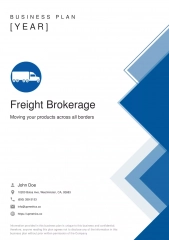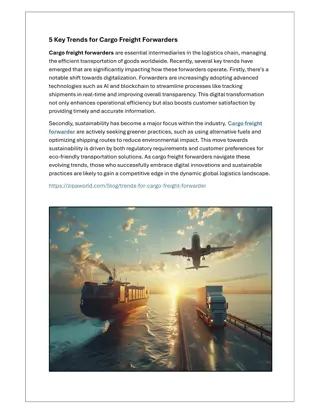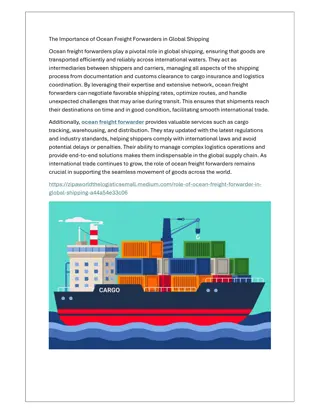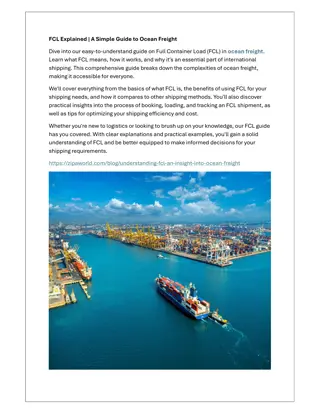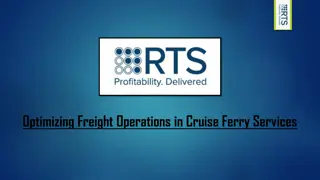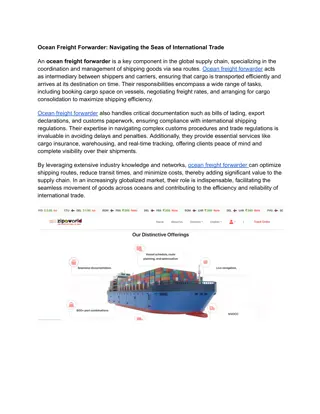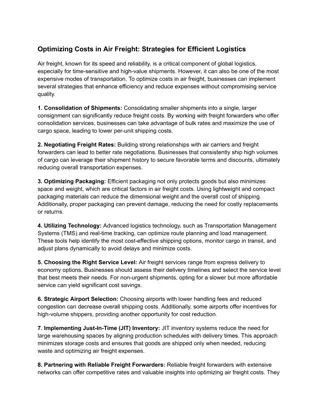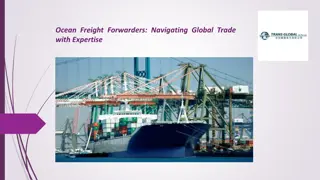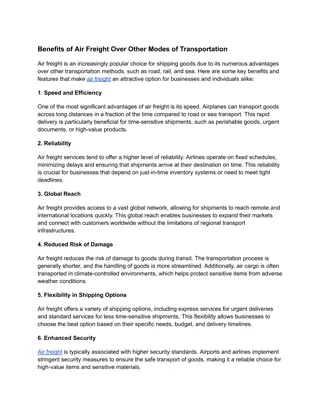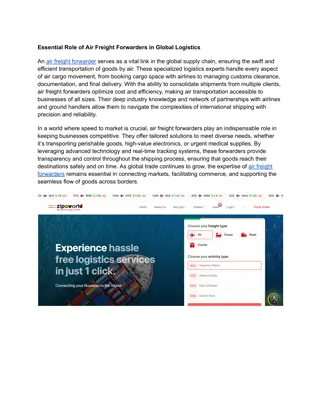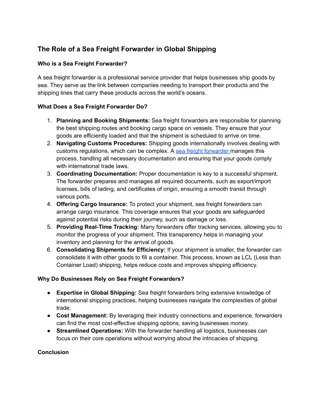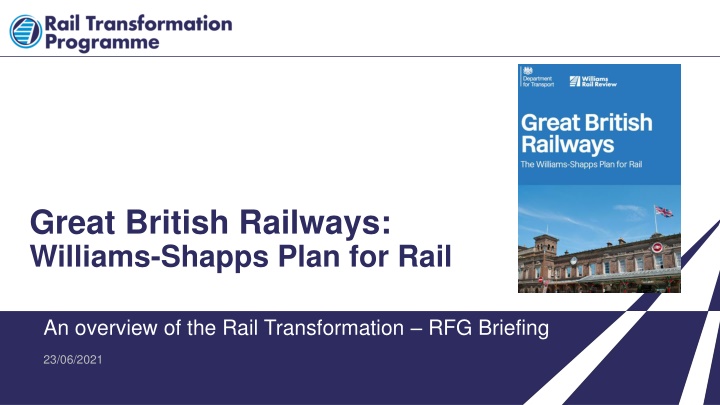
British Railways Transformation Plan: Williams-Shapps Overview
Explore the Williams Rail Review leading to the Williams-Shapps Plan for Rail, emphasizing the need for customer-focused, sustainable, and innovative changes in the railway sector. Learn about the key problems identified, the structure of the plan, and the 10 key outcomes aimed at simplifying the industry structure and providing a modern passenger experience. Discover how the plan envisions a single, national leadership and a new brand identity to improve services and connectivity.
Download Presentation

Please find below an Image/Link to download the presentation.
The content on the website is provided AS IS for your information and personal use only. It may not be sold, licensed, or shared on other websites without obtaining consent from the author. If you encounter any issues during the download, it is possible that the publisher has removed the file from their server.
You are allowed to download the files provided on this website for personal or commercial use, subject to the condition that they are used lawfully. All files are the property of their respective owners.
The content on the website is provided AS IS for your information and personal use only. It may not be sold, licensed, or shared on other websites without obtaining consent from the author.
E N D
Presentation Transcript
Great British Railways: Williams-Shapps Plan for Rail An overview of the Rail Transformation RFG Briefing 23/06/2021
The Williams Rail Review The Williams Rail Review The Williams Rail Review led by Keith Williams was launched in 2018 A full range of options were assessed and considered to form a package of solutions for the whole system. Extensive research into passenger,freight customer and operator needs and trust in rail. Focus group sessions across different regions enabled the Review to focus on users not just structures, and to identify the key problems. The Review s findings underpin the Williams-Shapps Plan for Rail. Urgent and radical change is needed to help the railways become more customer focused and financially sustainable, working in the national interest as a public service. The Williams Rail Review identified six key problems: 1 2 3 4 5 6 The rail sector too often loses sight of its customers, both passengers and freight; It is missing opportunities to meet the needs of the communities it serves; It is fragmented and accountabilities are not always clear, The sector lacks strategic direction; It needs to become more productive and tackle long-term costs; It struggles to innovate and adapt. 2 Rail Transformation Programme Official
The Journey to Publication 2019 Call for Evidence is launched Keith Williams visited 200 stakeholders May 2018 Timetable crisis The Call for Evidence received over 750 responses The Review s evidence papers were published March 2020 Covid-19 hits Covid-19 emergency measures introduced Williams Rail Review recommendations tested in the light of the pandemic The Future Detailed engagement with the sector will begin to design and deliver reforms September 2018 Williams Rail Review is commissioned We are here! May 2021 The William-Shapps Plan for Rail White Paper is published as a result of the review 3 Rail Transformation Programme Official
The Williams-Shapps Plan for Rail is structured around Eight Chapters 4 Rail Transformation Programme Official
The White Paper Reforms 10 key outcomes Simpler industry structure Modern passenger experience Track and train to come together in GBR acting as a guiding mind for the system with a single, national leadership and a new brand & identity. It will: High quality, consistent services Accessible, reliable journeys that are well connected with other transport services Run and plan the network, own the infrastructure, and collect most fare revenue o procure passenger services and set most fares and timetables o be made up of regional divisions that are locally rooted and accountable, with new culture and incentives focused on serving customers. o New customer offers at stations and on trains A 30-year strategy will enable the sector to modernise efficiently Andrew Haines will develop plans to establish interim arrangements, drawing on expertise from across the industry and beyond, including RDG, the DfT and Network Rail. This will be alongside the existing role as CEO of Network Rail New way of working with the private sector Retail revolution New contracts will replace franchising, bringing a new focus on reliability, performance and efficiency A new customer offer will be driven by clearer prices, easy to understand information and simpler travel with both contactless and cashless payment options New opportunities for innovators, suppliers (including small and local partners) and funders will be created through streamlined contracts and more contestability Private sector innovation has unlocked spectacular growth on the railways We are committed to maintaining a major role for private business and capital in supporting Britain s railways in the future Compensation will be simpler to claim, and journeys will become easier across transport services Our new contracts will tailor services directly to different markets and parts of the network, sharing risk and revenue appropriately. We will aim to compete every contract, starting with initialcompetitions beginning in 2022 5 Rail Transformation Programme Official
The White Paper Reforms 10 key outcomes Increased speed of delivery and efficient enhancements Greater control for local people and places New offer for freight Railways will be more responsive to the needs of local communities. Empowered, locally-led teams will support improvements and be accountable to the people and places they serve. Restoring lost rail links and accelerating the delivery of critical upgrades to the network will help level up places across the country, spark new economic growth, and improve public transport connectivity and prosperity across our nations and regions. National co-ordination, greater opportunities for growth and strong safeguards will put rail freight on the front foot. Our reforms present a real opportunity for the freight industry to grow and prosper. The Williams-Shapps Plan for Rail will help drive rail freight growth and improve performance and efficiency across the network. Economic recovery and financially sustainable railways Skilled, innovative workforce Cleaner, greener railways Railways will spearhead the nation s ambitions in becoming a world leader in cleaner greener transport [Environment Plan in 2022 and ambition to remove diesel only trains from the network by 20240] Decarbonisation, biodiversity and improvements in air quality in towns and cities will ensure rail is the backbone of a cleaner greener public transport network Rail Freight plays a key role in our Net Zero carbon targets and is integral to the government s ambitions economic and environmental agenda a world leader in The railways are a public service, paid for by taxpayers and passengers to connect places and foster economic growth through levelling up across our towns, cities, and regions. Enhancing skills, leadership and diversity across the sector will create new opportunities for the hundreds of thousands of people working on our railways. High value jobs for the future will be created and make the most of data and technology to better support customers. Bringing together responsibility for cost and revenue in Great British Railways will ensure the railways become more financially sustainable. 6 Rail Transformation Programme Official
White Paper Reforms for Freight The economic and environmental benefits of rail freight will be supported by a new, customer focused approach, modern track access rights and new safeguards Simplification is more important than nationalisation Critical safeguards will be introduced to ensure freight operators receive fair access to the railway. A new, rules-based track access regime governed underpinned by legislation will be established that, though not set in stone, cannot change by GBR sole initiative. It will be designed in partnership with the market as part of a wider track access framework consultation. The ORR will act as an appeals body for operators or applicants to ensure GBR applies policies including track access and charging, fairly. Great British Railways will also have a statutory duty to promote rail freight to secure economic, environmental and social benefits for the nations. Alongside this, the government will issue guidance on its priorities for rail freight in each funding settlement. To improve customer experience, a national freight co-ordination team will be created within GBR to act as a single point of contact for freight operators and customers across the network. It will help embed freight firmly into strategic decision making, including incorporating freight into the railways new 30-year strategy. Future access agreements could support the growth of the rail freight market by including more flexible use of train paths and simpler ways of charging or building upon the offer of longer contract terms to support investment by operators. A methodology to better assess the value of rail freight will help to support decision-making and will be reinforced by more open data. The government will work with the market to consider vital network enhancements that increase capacity for freight and help to grow the rail freight market. The railways consist of dozens of organisations, each with silos and individual priorities that do not always work together. We will keep the best elements of the private sector that have helped us drive growth Freight is already a nimble, largely private sector market and will remain so. These reforms will support freight to grow and thrive. 7 Rail Transformation Programme Official
Rail Transformation Programme (RTP) The Rail Transformation Programme is being set up within the Department for Transport and rail industry to: Establish a common understanding of the vision for the railways Set out the phases of delivery Work collectively with the sector to design and implement this major project Government will also establish an advisory group to support the Secretary of State in ensuring the proposals are implemented across the sector. Keith Williams has been asked to chair this group. Andrew Haines (Chief Executive, Network Rail) has been asked to develop plans for establishing interim arrangements, drawing from across the industry and beyond. DfT is responsible for leading policy development, including any legislation that is required to deliver the reforms set out in the Williams-Shapps Plan for Rail. The Reform Delivery and Access team in RTP is leading policy development in relation to: Rail Freight and Access Reform Charging and Incentives ORR Reform We are working closely with NR, ORR, DfT BAU teams (including freight) and will engage with stakeholders throughout the policy development process, ahead of a public consultation (likely to be later this year). We welcome the opportunity to share further updates with you in the coming months. 8 Rail Transformation Programme Official

